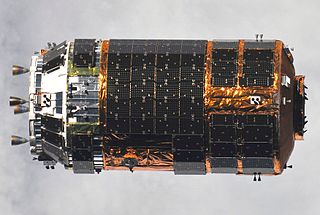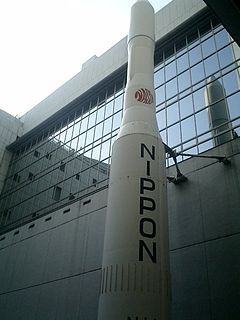| Look up JAXA in Wiktionary, the free dictionary. |
JAXA is Japan's national space agency.
Contents
Jaxa or JAXA may also refer to:
| Look up JAXA in Wiktionary, the free dictionary. |
JAXA is Japan's national space agency.
Jaxa or JAXA may also refer to:

Koichi Wakata is a Japanese engineer and a JAXA astronaut. Wakata is a veteran of four NASA Space Shuttle missions, a Russian Soyuz mission, and a long-duration stay on the International Space Station. During a nearly two-decade career in spaceflight, he has logged more than eleven months in space. During Expedition 39, he became the first Japanese commander of the International Space Station. Wakata flew on the Soyuz TMA-11M/Expedition 38/Expedition 39 long duration spaceflight from 7 November 2013 to 13 May 2014. During this spaceflight he was accompanied by Kirobo, the first humanoid robot astronaut.

Hayabusa was a robotic spacecraft developed by the Japan Aerospace Exploration Agency (JAXA) to return a sample of material from a small near-Earth asteroid named 25143 Itokawa to Earth for further analysis. Hayabusa, formerly known as MUSES-C for Mu Space Engineering Spacecraft C, was launched on 9 May 2003 and rendezvoused with Itokawa in mid-September 2005. After arriving at Itokawa, Hayabusa studied the asteroid's shape, spin, topography, color, composition, density, and history. In November 2005, it landed on the asteroid and collected samples in the form of tiny grains of asteroidal material, which were returned to Earth aboard the spacecraft on 13 June 2010.

The Japan Aerospace Exploration Agency (JAXA) is the Japanese national aerospace and space agency. Through the merger of three previously independent organizations, JAXA was formed on 1 October 2003. JAXA is responsible for research, technology development and launch of satellites into orbit, and is involved in many more advanced missions such as asteroid exploration and possible human exploration of the Moon. Its motto is One JAXA and its corporate slogan is Explore to Realize.

The H-II Transfer Vehicle (HTV), also called Kounotori, is an expendable, automated cargo spacecraft used to resupply the Kibō Japanese Experiment Module (JEM) and the International Space Station (ISS). The Japan Aerospace Exploration Agency (JAXA) has been working on the design since the early 1990s. The first mission, HTV-1, was originally intended to be launched in 2001. It launched at 17:01 UTC on 10 September 2009 on an H-IIB launch vehicle. The name Kounotori was chosen for the HTV by JAXA because "a white stork carries an image of conveying an important thing, therefore, it precisely expresses the HTV's mission to transport essential materials to the ISS". The HTV is very important for resupplying the ISS because after the retirement of the Space Shuttle it is the only vehicle that can transfer new 41.3 in wide International Standard Payload Racks (ISPRs) and dispose old ISPRs that can fit the 51 in wide tunnels between modules in the US Orbital Segment.

Gryf, also known as Jaxa, is a Polish coat of arms that was used by many noble families in medieval Poland and later under the Polish–Lithuanian Commonwealth, branches of the original medieval Gryfita-Świebodzic family as well as families connected with the Clan by adoption at ennoblement or even by error.

Akatsuki, also known as the Venus Climate Orbiter (VCO) and Planet-C, is a Japanese (JAXA) space probe tasked to study the atmosphere of Venus. It was launched aboard an H-IIA 202 rocket on 20 May 2010, and failed to enter orbit around Venus on 6 December 2010. After the craft orbited the Sun for five years, engineers successfully placed it into an alternative Venusian elliptic orbit on 7 December 2015 by firing its attitude control thrusters for 20 minutes and made it the first Asian satellite orbiting Venus.

Organizacja Wojskowa Związek Jaszczurczy was an organization of Polish resistance in World War II. Created in 1939 and transformed into National Armed Forces in 1942, it represented the far right of the Polish political spectrum and so refused to recognise the internationally-recognised Polish Underground State although there was some uneasy tactical cooperation for practical reasons. It also refused to recognise the Soviet-aligned Polish Committee of National Liberation and continued to resist the new Polish communist regime after the war.

The N-I or N-1 was a derivative of the American Thor-Delta rocket, produced under license in Japan. The N stood for "Nippon" (Japan). It used a Long Tank Thor first stage, a Mitsubishi Heavy Industries-designed LE-3 engine on the second stage, and three Castor SRMs. Seven were launched between 1975 and 1982, before it was replaced by the N-II. Six of the seven launches were successful, however on the fifth flight, there was recontact between the satellite and the third stage, which caused the satellite to fail.

IKAROS is a Japan Aerospace Exploration Agency (JAXA) experimental spacecraft. The spacecraft was launched on 20 May 2010, aboard an H-IIA rocket, together with the Akatsuki probe and four other small spacecraft. IKAROS is the first spacecraft to successfully demonstrate solar sail technology in interplanetary space.

162173 Ryugu, provisional designation 1999 JU3, is a near-Earth object and a potentially hazardous asteroid of the Apollo group. It measures approximately 1 kilometre (0.62 mi) in diameter and is a dark object of the rare spectral type Cb, with qualities of both a C-type asteroid and a B-type asteroid. In June 2018, the Japanese spacecraft Hayabusa2 arrived at the asteroid. After making measurements and taking samples, Hayabusa2 left Ryugu for Earth in November 2019 and returned the sample capsule to Earth on 5 December 2020.
Nikifor Romanovich Chernigovsky was a Polish noble who was exiled to Siberia over the course of the Polish-Russian war. In 1656, he murdered the voivode of Ilimsk for raping his daughter, and fled to the Amur where he reoccupied the ruins of Albazin and gathered a band of supporters forming the state of Jaxa.

Jaxa was a 17th-century microstate in North Asia with its capital in Albazino existing between 1665 and 1685. It was located on the border of the Tsardom of Russia and Qing China. The language commonly used in the state was Polish. It was subsequently annexed by Qing China.
A number of different spacecraft have been used to carry cargo to and from space stations.

Jaxa of Köpenick was a prince of the West Slavic Sprevan Duchy of Kopanica. He was an opponent of Albert the Bear during the formation of Brandenburg in 1157.

Arase, formerly known as Exploration of energization and Radiation in Geospace (ERG), is a scientific satellite to study the Van Allen belts. It was developed by the Institute of Space and Astronautical Science of JAXA. While there was a scientist working on a similar project with the surname Arase, the satellite's name has nothing to do with him but instead named after a river beside the launch point.

Małachowski is a Polish surname, it may refer to:

The CALorimetric Electron Telescope (CALET) is a space telescope being mainly used to perform high precision observations of electrons and gamma rays. It tracks the trajectory of electrons, protons, nuclei, and gamma rays and measures their direction, charge and energy, which may help understand the nature of dark matter or nearby sources of high-energy particle acceleration.
Smart Lander for Investigating Moon (SLIM) is a lunar lander being developed by the Japan Aerospace Exploration Agency (JAXA). The lander will demonstrate precision landing technology. By 2017, the lander was planned to be launched in 2021, but this has been subsequently delayed to 2022 due to delays in SLIM's rideshare mission, X-Ray Imaging and Spectroscopy Mission (XRISM).
DESTINY+ (Demonstration and Experiment of Space Technology for INterplanetary voYage with Phaethon fLyby and dUst Science) is a planned mission to flyby the Geminids meteor shower parent body 3200 Phaethon, as well as various minor bodies originating from the "rock comet". The spacecraft is being developed by the Japanese space agency JAXA, and will demonstrate advanced technologies for future deep space exploration. As of 2020, DESTINY+ is planned to be launched in 2024.
OMOTENASHI is a small spacecraft and semi-hard lander of the 6U CubeSat format that will demonstrate low-cost technology to land and explore the lunar surface. The CubeSat will also take measurements of the radiation environment near the Moon as well as on the lunar surface. Omotenashi is a Japanese word for "welcome" or "Hospitality".